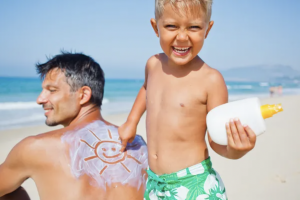July is UV Safety Month: Here are Tips to Protect Yourself from UV Rays
 Protecting your skin from sunburn is important year-round, not just throughout the summer. Too much exposure to ultraviolet (UV) rays from the sun and artificial sources such as tanning beds may cause sunburn or skin damage. It also increases the risk for skin cancer and early skin aging.
Protecting your skin from sunburn is important year-round, not just throughout the summer. Too much exposure to ultraviolet (UV) rays from the sun and artificial sources such as tanning beds may cause sunburn or skin damage. It also increases the risk for skin cancer and early skin aging.
Who is at Risk for UV Damage?
The harmful effects of UV rays can affect people of all skin colors; however, the risk increases for people who have light-colored skin, hair, or eyes. The Centers for Disease Control and Prevention (CDC) indicates that those who have a family member with skin cancer are at risk too.
Spending a lot of time outdoors for work or recreation without protective clothing and sunscreen increases risk. People who take medications that may increase sun sensitivity should also consult their healthcare provider about precautions to take.
Protecting Yourself from UV Rays
UV rays tend to be the strongest from 10 a.m. to 4 p.m. daylight saving time (9 a.m. to 3 p.m. standard time) in the continental United States, according to the CDC. Limit your UV ray exposure during these hours and take these additional steps:
- Seek shade. Stay in the shade as much as possible. Seek the shade from a tree, umbrella, or wherever you can to protect yourself from the sun’s harmful UV rays.
- Wear clothing that covers areas that are typically exposed when possible. A long-sleeve shirt, beach cover-up, T-shirt, pants, or clothes made from tightly woven fabric helps protect from UV rays. Dry, dark-colored clothing may offer better UV protection than those that are light-colored or wet. UPF (ultraviolet protection factor) clothing can also be worn.
- Choose a wide-brim hat. This type of hat provides shade to the face, ears, and back of the neck. Darker hats or those made with tightly woven fabric such as canvas may offer better protection against UV rays than straw hats, which let sunlight through. A baseball cap can also be worn with a handkerchief or other cloth underneath it to cover the neck and ears.
- Wear sunglasses. They protect your eyes during prolonged UV exposure and decrease the risk of damage to eye tissue, developing cataracts, and contracting other eye conditions. Choose sunglasses that have 100 percent UV-protective coating. Oversized or wraparound sunglasses help block UV rays from entering the eye from the side.
- Use sunscreen. Use broad-spectrum sunscreen with a sun protection factor (SPF) of 15 or higher for protection from UV rays. Sunscreen is usually not recommended for babies who are 6-months old or younger. Keep them out of direct sunlight and dress them in hats and protective clothing.
- Teach children about sun exposure. Children tend to spend a lot of time outdoors and can get a sunburn easily. Teach them about the dangers of too much sun exposure and the importance of applying sunscreen.
- Avoid or limit the use of tanning beds. Tanning beds emit UV radiation, which has been linked with an increased risk of long-term skin damage and skin cancer.
- Get some Vitamin D. Although the skin makes Vitamin D naturally when exposed to sunlight, it can also be obtained from food or dietary supplements.
Before you head out to the beach or to enjoy the great outdoors this summer, visit Carmichael’s Crowley location. We have a selection of over-the-counter sunscreen brands that will help protect your skin from harmful UV rays and a variety of supplements to meet your Vitamin D needs.




 Accredited/Certified by The Joint Commission
Accredited/Certified by The Joint Commission